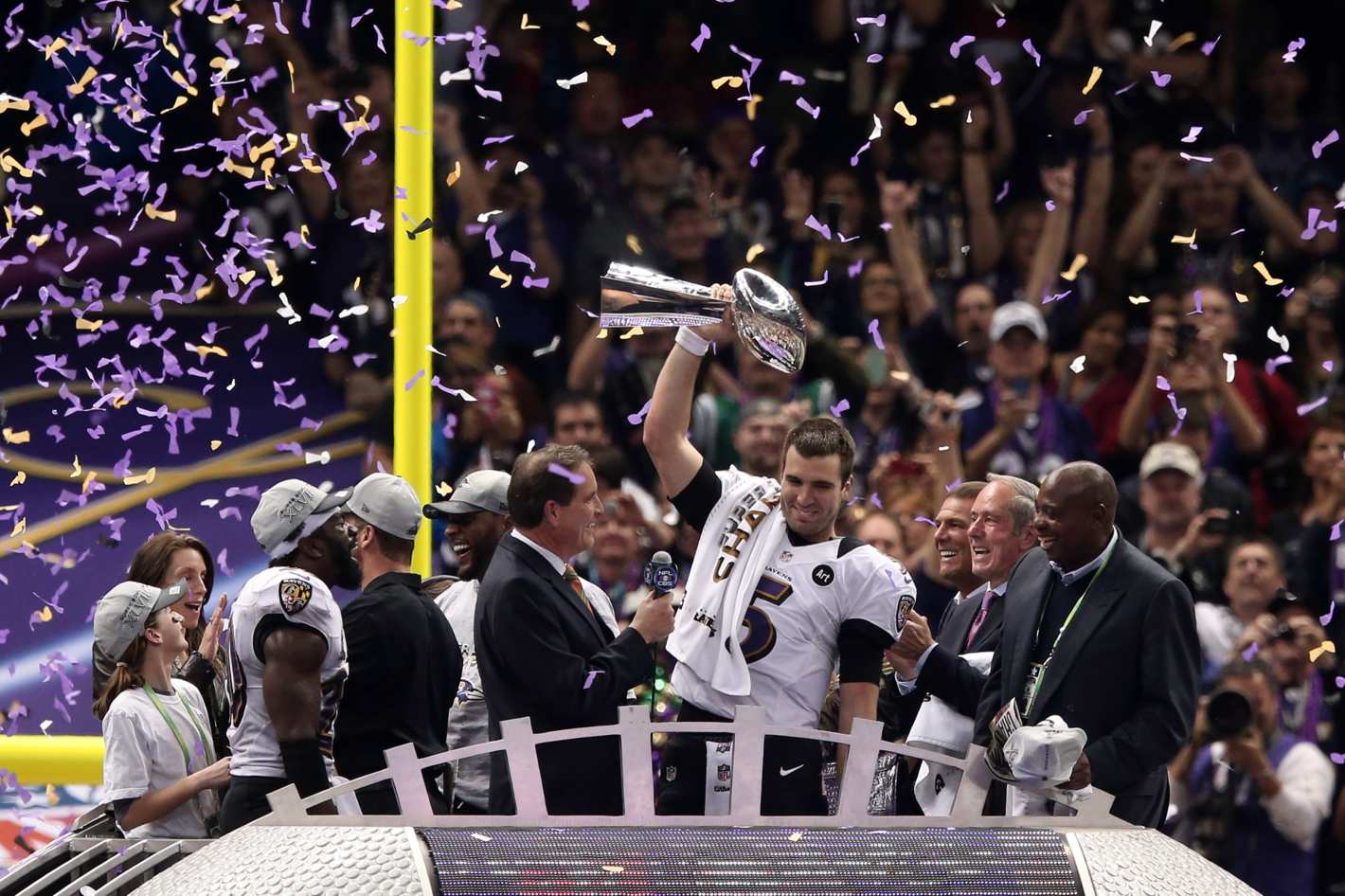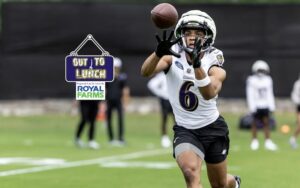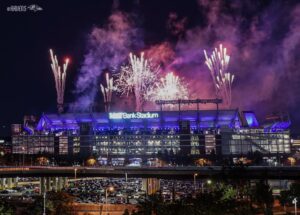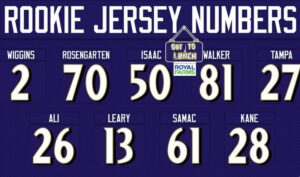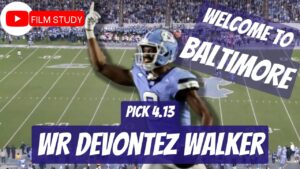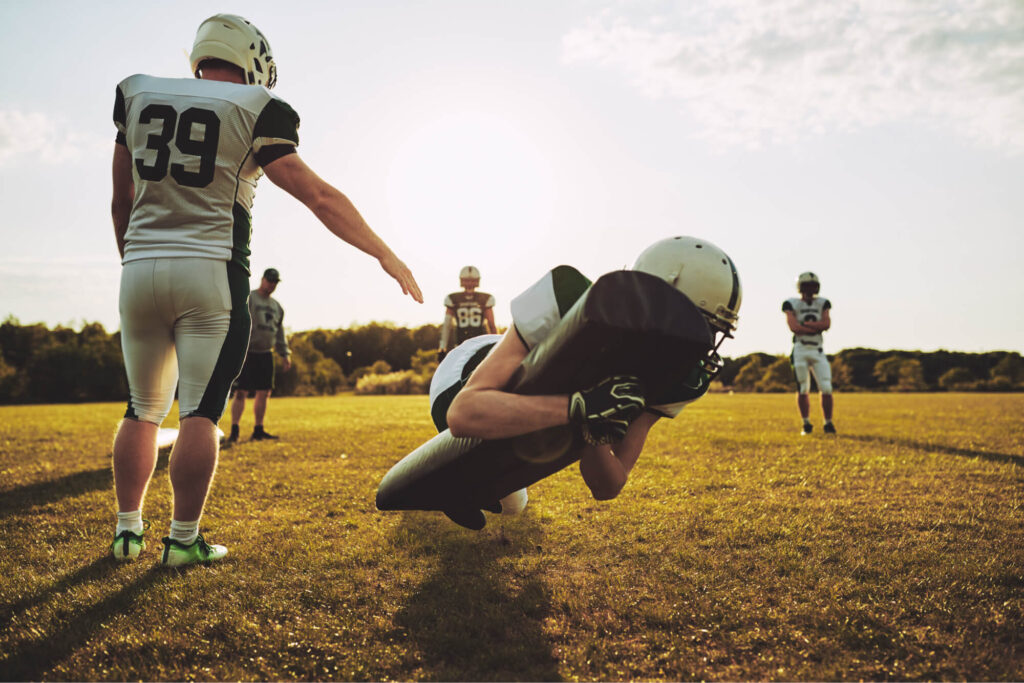Ryan Mavity has written for the Cape Gazette in Lewes, Del. since 2007. He’s working on his first book, about the Colts of the 1970’s, “Ghosts of 33rd Street: The Final Glory Days of the Baltimore Colts.” This is an excerpt from that book.
It remains one of the most enduring images in pro football history.
Oakland Raiders tight end Dave “The Ghost” Casper, running towards the right end zone of Baltimore’s Memorial Stadium, looking over his head, snagging a wobbly heave from Ken Stabler.
The Ghost to the Post.
On Christmas Eve, 1977, the Baltimore Colts played their final playoff game in Baltimore. The moment before Casper caught that famous pass with 2:30 left in what would be a 37-31 double overtime Raiders win, was Gettysburg just before Pickett’s Charge. Before dark days of losing. Before an endless game of musical chairs over where the franchise would end up. Before the team’s owner became a league wide punchline. Before moving trucks would show up in Owings Mills and haul the Colts off in the middle of a snowy March night in 1984, bound for Indianapolis.
The 1977 season was supposed to be the culmination of the Colts’ chase for the Super Bowl.
“We were really confident we should be a team that goes to the Super Bowl. That’s all we talked about, going to the Super Bowl,” linebacker Stan White said.
The Colts had shocked the NFL in 1975 by going from worst to first, rebounding from a 1-4 start to win nine straight games and an AFC East championship. That team emerged from a great deal of angst.
Chicago air conditioning magnate Robert Irsay had traded for the team in 1972 in an unprecedented action in which he bought the Rams and traded them to Carroll Rosenbloom in exchange for the Colts. Rosenbloom had been a controversial figure among the Baltimore fans and media, but in the building, he was a beloved figure because the players felt he cared for them. He gave them bonuses, checked up on their families, knew their names and helped set them up in business in the community.
Center Ken Mendenhall was the 40th man on the 40-man roster in 1971, having bounced between Atlanta, Houston, Green Bay, the Giants and then the Colts within the span of a year.
“When I made the team after the last cut down,” said Mendenhall, “he came up and introduced himself and welcomed me to the Colts family and he said, ‘If I can be of any assistance, please let me know.’ Very cordial and warm. I didn’t know if I would be there two weeks or two years. He was very kind.”
Ernie Accorsi, who began his career with the Colts as the public relations director before going on to a long career as a general manager, said of Rosenbloom, “He’d chew you out, but if he thought he upset you, he would do something within five hours to lift your spirits again. I remember one time he called me. He wasn’t happy with something that was in the paper and my wife was in tremendous pain, it was a Sunday morning. I thought she was having appendicitis attack. Right in the middle he calls me and I say, ‘Mr. Rosenbloom I hate to tell you this but I think I’m going to have to rush my wife to the hospital.’ Well he turned on a dime and said, ‘Don’t move,’ and he sent the team doctor right to my apartment. That’s him in a nutshell. If you needed him, you always thought he was going to be there. I loved the man. The players loved him.”
Irsay, on the other hand, was known to love to drink and referred to everyone as “Tiger,” because he couldn’t remember anybody’s name.
Safety Bruce Laird once decided to have a little fun with this trait of Irsay’s by switching his nameplate with that of 5-foot-5 inch kick returner Howard Stevens, who was black, while Laird was 6-foot-2 and white.
“He would come in with six, eight, 10 people. They’re all probably Chicago people, come into the locker room. He really was never around except for games. He really didn’t know us. He knew our numbers. He called everybody ‘Hey, Tiger,’ because he didn’t know who we were. So I said, ‘Watch this, I’m gonna just [mess] with him.’ I put tape over my cubie and I go sit over at Howard’s thing. So I go over to Howard and he looks and goes, ‘Hey, Howard, great game tonight.’ I go, ‘No, Bob, I’m Bruce, I was just coming over to sit in Howard’s stub for a while.’ Everybody is in the background laughing their ass off.”
Cornerback Doug Nettles remembered a 1977 game in Seattle where Irsay came into the locker room and started fuming to Nettles over calls that had gone against the Colts. One problem: Irsay addressed Nettles as “Lydell,” confusing him for running back Lydell Mitchell. While Mitchell and Nettles are both black and both had large afros at the time, they are in fact different people.
“Next week, they hired this guy, and we didn’t know who this fool was, walking around introducing himself to people, and it’s like, ‘He ain’t a coach, he must be from the front office.’ Finally, somebody after practice asked, ‘Who the hell are you?’ He says, ‘Well I’m Bob’s new special assistant.’ What it was, they hired this guy to get to know every last one of us and whenever Bob came, he was always behind him whispering our names in his ear so he wouldn’t make that mistake again,” Nettles said.
Irsay didn’t exactly endear himself to the veteran-laden team at his first training camp in August 1972.
Veteran running back Tom Matte said, “He came into the team meeting, ‘My name is Bob Irsay and I’m the new owner of the Baltimore Colts.’ And I looked at Unitas and Unitas looked at me and we almost threw up. It was terrible. It was actually terrible. As you can imagine I’m not very fond of this guy.”
“He came in, we were told we were going to have a meeting, and Irsay was going to talk to the team,” receiver Sam Havrilak recalled. “We were used to a good 20-minute speech by Carroll Rosenbloom. Irsay came in, was very unsure of himself, had never owned a team before, hadn’t been in that situation, and didn’t know what to say or do. He only spoke for about five minutes, if that. Then he told everyone that his secret ambition was to receive a snap from center. So we went outside and Bill Curry, who was our center, centered the ball to him. I believe he jammed his finger when he did it.”
As part of acquiring the team, Irsay installed Joe Thomas as general manager. Thomas had been a highly thought-of personnel man with the Minnesota Vikings and Miami Dolphins, but he had lost his job in Miami after a power struggle with Coach Don Shula. Seeking to handpick his owner and have full autonomy over the team, Thomas helped bring Irsay into the fold to purchase the Colts.
Thomas had initially planned to rebuild slowly, integrating young players into the mix. But after a 21-0 loss to Dallas in which the team looked listless and was booed, Thomas decided to take a flamethrower to the roster. He fired Coach Don McCafferty, who had won the Super Bowl just two years earlier, and decided to take a scorched earth approach. He pressured interim coach John Sandusky into benching John Unitas.
It was a move that made Thomas a pariah in Baltimore. Moving on from the 39-year old, sore-armed quarterback wasn’t necessarily a bad move, but he humiliated the man who was essentially God in black hi-tops. Unitas was a legend, the man who had helped make pro football with his heroics in the 1958 NFL Championship Game. Thomas informed Unitas of his benching through a terse phone call. Their conversation, according to Unitas in 1976, went like this:
“John”
“Yeah”
“This is Joe Thomas”
“Yeah”
“I guess you know we fired McCafferty.”
“Yeah, I heard it on the radio.”
“That means we’re going to be playing the younger players a lot more.”
“Fine.”
“Okay.”
Click.
Once the 1972 season was over, and the Colts had finished 5-9 after a 1-4 start, Thomas began shipping players to all kinds of places. Gone were Matte, Bubba Smith and Bill Curry, among others. Unitas was unceremoniously sold to San Diego.
Besides the impersonal way he blew up the roster, Thomas’s healthy ego also made him persona non grate in Charm City.
“It’s embarrassing,” he once boasted. “But I guess I never had a bad trade.”
Thomas made some moves out of spite, like when he traded Ted Hendricks to Green Bay after Hendricks had signed a contract to play for the Jacksonville Sharks of the World Football League.
Team secretary Maureen Kilcullen recalled, “Ted loved Miami, he grew up there, he wanted to stay in a warm climate. He loved Baltimore, but if they were going to trade him he wanted to go somewhere close to home. That was a catalyst for him signing with the Jacksonville team in the WFL. Joe Thomas viewed that as a breach of trust and a disloyal move,” Kilcullen said. “Ted was traded to Green Bay, which of course is the coldest city in the NFL. But during the 74 season, I was still in touch with Ted and his wife Jane. Joe Thomas was combing his hair in a mirror in our little office and he started talking about loyalty, and his final line was ‘I don’t care what anybody says, you can’t tell me that Ted Hendricks likes it in Green Bay.’ I was tempted to say, ‘He actually loves it.’ But I kept my mouth shut.”
Still, Thomas could find players. Accorsi said he got his whole drafting philosophy from Thomas, who believed in building through the quarterback first and pass rush second and a big-time receiver third. Accorsi said Thomas preferred not to spend high draft picks on offensive lineman, a principle he broke when he drafted Ken Huff third overall in the 1975 draft, passing over Walter Payton in the process.
But in 1973 and 1974, Thomas hit the draft out of the park, bringing in the building blocks of three straight division championship winners: Bert Jones, Joe Ehrmann, Fred Cook, Mike Barnes, John Dutton, Roger Carr, Robert Pratt, Freddie Scott, David Taylor, Ray Oldham and Doug Nettles. In 1975, he brought in All-Pro right tackle George Kunz, which solidified the offensive line. That same year he brought in Washington Redskins offensive coordinator Ted Marchibroda as head coach.
Marchibroda had spent nearly a decade under the hyper-organized George Allen. While Allen was known for being high strung and paranoid, Marchibroda was grandfatherly and easygoing.
“Ted brought a sense of cohesiveness,” said defensive tackle Joe Ehrmann. “He tried to take this very dysfunctional family and create some kind of order to it. I think everybody was ready for him. We were waiting to be led. There was such chaos. I think everybody was looking for structure. Ted was very structured, a George Allen disciple. I think Ted and that coaching staff brought a sense of relief, a sense of hope.”
Offensive guard Ken Huff said, “He was not a real rah-rah sort of a coach. He was not a fire and brimstone kind of a coach. He was very business-like in his approach. You got the impression that he trusted us as players and as a player that’s one of the most important things you need to have.”
“He let you do your job,” defensive coordinator Maxie Baughan said of his boss. “That was the biggest thing. He did his job, we did our job and everything was fine.”
Among Marchibroda’s new staff was a 23-year-old football prodigy from Annapolis named Bill Belichick.
Bill’s father, Steve Belichick, was friendly with Colts special teams coach George “Bootsy” Boutselis and it was through this connection Belichick came onto Marchibroda’s radar. Belichick started working for free, but gradually moved up the pay scale, first to $25 per week and then $50 a week by midseason.
It’s hard to fathom today that the man who would become arguably the greatest coach in NFL history was once staying in a Howard Johnson’s at Friendship Airport, but that is indeed how Belichick began his coaching career. Among his duties were driving Marchibroda, offensive coordinator Whitey Dovell, and Boutselis to the team’s practice site at McDonough High School and to Memorial Stadium.
“Bill Belichick took the job driving Ted. Why, because George Allen had a driver. So when Bill’s father called asking is there any room for my son who loves football and can really help you, Ted didn’t know Bill. Ted had no idea,” said Laird.
Belichick’s main contribution to the Colts was in the film room. Defensive coordinator Maxie Baughan put him to work right away, literally on his first day, breaking down film of the Rams-Redskins 1974 playoff game.
“Maxie showed me how to do all of the breakdowns the way that George Allen did them at Washington,” Belichick explained. “Maxie was the defensive signal caller in Washington, so I did 100 breakdowns a week to help the players, primarily Stan White, who was the signal caller for the Colts in 1975.”
Belichick would leave the Colts after the 1975 season, but his work in the film room was inspiring to Laird, a 1972 fifth-round pick from American International College in Springfield, Mass., who had clawed and scratched his way into becoming an NFL starter.
“He could pick out [stuff] that most people couldn’t dream of looking at,” Laird said. “I’m talking about flankers, third down, inside the numbers, outside the numbers. If they run inside the numbers, they run an out 78 percent of the time on certain down and distances. That’s what I got into. That was a special part of my life.”

Marchibroda, a former quarterback himself, was thought of as a top groomer of quarterbacks as an assistant. He took the education of Bert Jones as his prime assignment.
Jones had been back and forth between the field and the bench, caught in the middle of a power struggle between then-coach Howard Schnellenberger, Thomas, and Irsay. This power struggle culminated in Week 3 of the 1974 season, when Irsay invaded the sideline to ask Schnellenberger to play Jones, a request that was answered about the way you would expect. When Marchibroda came aboard, he began holding study sessions in the offseason to prepare the quarterback for the 1975 season.
Jones was a shaggy-haired country boy from Ruston, Louisiana, oozing with talent when the Colts picked him second overall in the 1973 draft. Joe Thomas had traded for Marty Domres the year before to be his quarterback of the future, running John Unitas out of town in the process. But he fell in love with Jones’s ability and traded defensive tackle Billy Newsome to New Orleans in exchange for the pick used to take Jones.
The man known as the Ruston Rifle impressed his new teammates right away.
“First time I saw him throw the ball, we were at Towson State. He had come from the college all-star game. First practice he lines up and he throws the ball and effortlessly goes about 70 yards. Everybody goes, ‘Domres is done,’” said White.
Stories of Jones’ arm strength are legendary amongst those who played with him, akin to Chessie sightings around Baltimore.
Nettles recalled, “We were in the open end of the stadium one Saturday morning and I was throwing rocks at some pigeons. I was getting halfway down the stadium and he said, ‘You ever play baseball?’ And I said, ‘Yes I did.’ He was throwing a ball; he always had a ball in his hands. He was on the 20-yard line and he says, ‘There’s some pigeons down in the closed end of the end zone. I can hit those pigeons down there with this ball.’ I said, ‘I bet $100 you can’t.’ And Ted heard us. We thought we were in trouble. He turned to us and says, ‘I’ll take that bet.’ And he stopped practice and he took that ball and hit those pigeons 80 yards away… I never paid him.”
“They called me and they wanted to have Bert throw the ball to me,” said wide receiver Glenn Doughty. “Man, that dude, he threw it like a rocket and it was a perfect spiral all the time. The speed of it was really amazing. I have three fingers to testify to the speed of his ball.”
“You know the Juggs machine that they use to put the ball in and shoot?” said wide receiver Freddie Scott. “Baseball they use it for pitching, but in football they would use it for kickoffs and punts. We would line up a Juggs machine 15 yards from us and line it up to shoot the ball at us. We literally had to go and react. That’s how we prepared for Bert’s passes. Just have the Juggs machine [set to] fast and you would have to react real quick.”
“The offensive linemen, we would get together and throw the ball and I could out throw anybody. Bert, he came over, he was watching us, and I threw the ball 55 yards. Bert got on his knees and threw it about 60. He forever just amazed me every time I saw him throw,” said guard Elmer Collett.
Besides his physical tools, Jones was a leader, who commanded respect in the huddle, as guard Robert Pratt once found out during a 1975 game against Cleveland.
“I had to play against this guy named Jerry Sherk, who was regarded as one of the best defensive tackles in the league,” Pratt said. “I think it was about my fourth or fifth start, and I was determined not to allow Jerry Sherk to get a sack on Bert. So, first quarter goes great, second quarter goes great, third quarter is going pretty good. We have a pass called and I’m blocking Jerry and blocking him and blocking him. Bert keeps holding the ball, looking for it. Finally Jerry Sherk gets by me and sacks Bert. I yelled at Bert, ‘Throw the [darn] ball!’ He got me in the huddle and he got down on one knee, he said, ‘If you ever talk to me ever again like that, you will never play another down in the NFL.’ And I said, ‘Yes, sir.’ I kept my mouth shut for the rest of my life with him. Put me in my place. That’s where I knew the quarterback was boss.”
Jones was a second generation player, the son of Cleveland Browns receiver and coach Dub Jones. Summer vacation was spent at Browns training camp, and young Jones was put to work.
“My job consisted of washing the socks and the jocks and the t-shirts. Making their rolls every day and putting them into lockers,” Jones said. “I guess I learned that even though Jim Brown was the greatest running back in the history of the NFL, he was just somebody that I knew every day. Frank Ryan, even though he was a Ph.D. in mathematics, he was just a good guy and somebody that I enjoyed warming up every day before practice. Just having that life experience was truly a lot of fun, it truly was.”
Jones was close with his offensive linemen, who doubled as his hunting buddies. Tuesdays were an off day for the Colts, so Jones would go with a group of linemen, usually guards Robert Pratt and Elmer Collett and tackle George Kunz, to Wye Mills, where Jones’ friend, Ed Boyd, had a farm.
“We loved to go dove hunting and loved to go duck and goose hunting down there. It was our opportunity to live a regular life on the Eastern Shore. We were not celebrities there, we were just people that came down every Tuesday and enjoyed the fruits of the beautiful environment we had there,” Jones said. “We would go hunting and then we would go to Easton. They had a poker game at the Chesapeake Bay Yacht Club there in Easton for probably 150 years.”
The poker game was mainly a locals-only affair, but Jones recalls the time he was allowed to sit at the table.
“They had all the royal flushes on the wall. It was more important than all the money in the world to be sitting at the table. The players at the table had an apprentice behind them and often times, one or two behind them. They would have an opportunity to play a hand, if the elder statesman had to go to the bathroom, which was quite frequent when you were 70,” he said. “I’ll never forget, I was playing a hand for Ed Boyd and I had everything but a royal flush except for an inside card and it was all eyes on Bert. I threw one card and I didn’t make it. To this day, I wish that my name with my card would be in a frame on the wall there.”
Jones and Joe Ehrmann were the team pranksters. Ehrmann had his Bonehead of the Week award for bad play, and Jones had some ingenious ways of punking unsuspecting teammates.
“Oh, you know, I guess if you throw water on Bert, be careful, he might blow up your car,” Jones says today with a laugh.
His magnum opus was the time Jones put a bird he’d killed on one of his hunting trips into the helmet of running back Lydell Mitchell.
“Everybody else had to come in for special teams. He was coming in at 10 a.m. for the regular meeting, five minutes to 10,” said cornerback Doug Nettles. “So Lydell comes in, he’s dancing around, ‘What are ya’ll doin? What’s happenin’? What’s happenin’?’ He had his little stacked heel shoes, like he had just come from the street. He’s standing around and his helmet is right here. Bert had took the goose, it had the head hanging out of the helmet. He turns around, ‘AHHHHH!!’ There’s a table sitting right there, he knocks the water off it, he’s falling all over.”
“He’d be getting ready and then a goose would be looking at him through his helmet,” Jones said.
“The helmets were on top of lockers, so Bert puts this dead goose in Lydell’s helmet with the beak sticking out of the facemask. So when Lydell reached up to grab his helmet, this goose falls right on top of him,” said Pratt.
“I’m not a hunter; I didn’t have to come to the meetings early, fortunately. I’m all set to get dressed real quick and I look up and here’s a dead pheasant in my locker,” Mitchell said. “It kind of woke me up because I always came in tired. I was awake after that.”
“He would not put the helmet on until he watched them fumigate it. Everybody is laughing and cutting up,” Nettles added.
“You thought the world was coming to an end for Lydell. It was hilarious. He was yelling and screaming at Bert Jones, he knew exactly who did it,” said Pratt.
“I’m sure he wasn’t as scared as he acted, but he would freak and it was a lot of fun. We had good times.” Jones said.
In 1975, Jones would have his finest season as a pro to that point, despite playing half the season with a painful rib injury. The Colts dream season would end on the hard Astroturf of Pittsburgh’s Three Rivers Stadium, as they fell to the defending – and soon-to-be repeating – world champion Steelers.
In 1976, the Colts were picked by many to step up into Super Bowl contention. The season was nearly derailed after Irsay tore into the team after a preseason loss, leading to Marchibroda and the coaching staff resigning en mass. Marchibroda blamed Thomas, who felt like he wasn’t getting enough of the credit. The players revolted and threatened to sit out the season opener. Irsay gave in and Marchibroda was back to lead the Colts to an 11-3 record.
The Colts would have a shot at revenge, hosting the Steelers in the first round of the 1976 playoffs. A raucous Memorial Stadium crowd was quickly silenced when Terry Bradshaw threw a 76-yard touchdown pass to Frank Lewis on the third play of the game and the Colts went on to lose 40-14. That game became more well-known when one Donald Kroner crashed his single-engine plane into the upper deck of Memorial Stadium. Thomas was fired after the season, having been reduced to a middle man after Irsay handed increased personnel power to Marchibroda.

So in 1977, the Colts felt like this would be their year. A 9-1 start gave way to a late season swoon, as the Colts lost three straight to fall into a three way tie for the division lead with the Miami Dolphins and New England Patriots. The final loss of the losing streak was an inexplicable defeat at the hands of the lowly Detroit Lions when the Colts lost on a blocked punt that was returned for a touchdown.
Still, the Colts entered their final game against the Patriots needing only a win to make the playoffs. Falling behind 21-3, Jones led a spirited comeback in the second half and the Colts held on to win 30-24.
The Colts would go into the playoffs hindered on offense, as wide receiver Roger Carr, the Colts’ top deep threat, would miss the game due to a knee injury. Carr had a huge 1976, leading the NFL in receiving yards with 1,112 and an astonishing yards per catch of 25.9 with 11 touchdowns. Carr had injured himself in the second week of the 1977 season and was never really right the rest of the year, playing only seven games and catching 11 balls for 199 yards.
Still, the Colts had Jones. While he didn’t put up the staggering numbers of 1976 (for an era with lax pass interference rules and not much throwing), he had another solid season in ’77, leading the league in pass completions, was second in attempts and passing yards and tied for fifth in touchdown passes.
Besides Jones, the Colts had weapons, chief among them running back Lydell Mitchell, who led the league in receptions with 71 and registered his third straight 1,000 yard season on the ground.
Backfield mate Don McCauley was the team’s third down and goal-line specialist and another outstanding pass catcher out of the backfield, pulling in 51 balls, fifth in the NFL.
The headliners of the Colts defense were the Sack Pack – Ehrmann, John Dutton, Fred Cook and Mike Barnes – a defensive line that helped sack quarterbacks 47 times in 1977. A revamped Colts secondary, featuring newcomers Norm Thompson and Lyle Blackwood combined with holdovers Laird and Nelson Munsey, pulled down 47 takeaways, third in the NFL.
Their opponents, for the third year in a row, would be the defending Super Bowl champions, in this case, the Oakland Raiders, the NFL’s resident badasses of the 1970s.
Prior to their triumph over the Minnesota Vikings in Super Bowl XI, the Raiders were known as the NFL’s perpetual bridesmaids, the Andy Reid Era Philadelphia Eagles of their day.
Since the promotion of John Madden to head coach in 1969, the Raiders had been the winningest franchise in pro football.
“We played our ass off for him personally,” fullback Mark Van Eeghen said of Madden. “We all did. He was such a motivating sort of coach. I never saw him chew out Upshaw or Stabler but he would chew out whoever he had to chew out and get on. We didn’t take it as getting chewed out. We knew our coach was right. We messed up a play and we felt bad that we did. Respect is about the best word that I can come up with. We respected the heck out of him.”
In his first season, Madden’s Raiders lost to their arch rivals, the Kansas City Chiefs, in the final AFL championship game in 1969. The next year, they lost the first AFC championship game to the Colts, in a game in which Bubba Smith knocked quarterback Daryle Lamonica, aka the Mad Bomber, out of the game early.
In 1971, the Raiders missed the playoffs – one of only two times that would happen under Madden – but returned the next year against the upstart Pittsburgh Steelers where they lost on arguably the most famous play in NFL history: the Immaculate Reception, a 60-yard pass from Terry Bradshaw to running back Franco Harris that bounced off Raiders safety Jack Tatum and into the arms of Harris. For the Raiders, the play was less Immaculate then a screwjob. They always maintained that the ball touched Steelers running back John “Frenchy” Fuqua first, making the play illegal – as the ball can’t touch two offensive players in a row.
The next year, the Raiders would get their revenge against the Steelers in the divisional round but would fall in the championship game to the Miami Dolphins. In 1974, the Raiders were favored at home in the AFC title game against the Steelers, and held a 10-3 lead going into the fourth quarter. But the defense gave up 21 fourth quarter points and Oakland lost, 24-13.
The rematch came a year later at Pittsburgh’s Three Rivers Stadium in one of the most brutal football games ever played. The day before the game, a freezing rainstorm hit Pittsburgh. The tarp covering the Astroturf field at Three Rivers had ripped along each sideline. The ripped tarp allowed freezing rain to accumulate on the sides of the field, turning the area near the sidelines into an ice skating rink. The Raiders maintained that the Steelers grounds crew purposefully sabotaged the field, knowing that the Raiders strength was throwing the deep ball on the outside. The weather conditions exacerbated the brutality of the game, which was highlighted by Raiders safety George Atkinson clotheslining Lynn Swann and knocking Swann out of the game. The Steelers would win the game 16-10, and the Raiders had once again fallen short of the Super Bowl.
The 1976 season was where it finally came together. They went 13-1 during the regular season before surviving the New England Patriots in the first round of the playoffs. The game became known for a controversial call late in the fourth quarter when Patriots defensive lineman Ray “Sugar Bear” Hamilton was called for roughing the passer on Ken Stabler. That kept the Raiders alive for Stabler to run in the game-winning touchdown.
The next week, the Raiders beat a banged up Steelers team, 24-7 in the AFC Championship Game. The Steelers were missing Franco Harris and Rocky Bleier after they were injured during the divisional round against the Colts, but that mattered little to the Raiders, who finally had gotten past a bitter rival.
In Super Bowl XI, the Raiders crushed the Minnesota Vikings, 32-14, running and passing at will and physically dominating the aging Vikings. Raider tackle Art Shell so thoroughly controlled Minnesota’s Jim Marshall that Marshall did not record any statistics: no sacks, no tackles and no assists. Raiders safety Jack Tatum provided one of the game’s signature plays when he obliterated Vikings wideout Sammy White running across the middle. White’s headgear flew off and Tatum claimed that White was on the ground wondering where his eyes were.
The game’s other signature play was a 74-yard interception return by veteran corner Willie Brown to seal the Raiders win. The image of “Old Man Willie,” as Raiders broadcaster Bill King called him, running down the sidelines in slow motion, with his helmet flopping on his head, is one of NFL Films’ most enduring images.
But in 1977, the Raiders weren’t quite as good as they had been in 1976. Stabler spent the year playing through knee injuries. Middle linebacker and inspirational leader Phil Villapiano also spent most of the year hurt.
Injuries also forced the Raiders to reshuffle their secondary, known as the Soul Patrol. Cornerback Skip “Dr. Death” Thomas had to shift to strong safety to cover for the loss of Atkinson, known for his fearsome “hook,” a clothesline-style tackle he used to injure Swann in the 1975 AFC Championship Game and in the 1976 season opener. Thomas’ spot at cornerback would be taken by rookie Lester Hayes.
Although Atkinson would be out, the Raiders would have their biggest intimidator: “The Assassin” Jack Tatum.
Tatum had a reputation for big hits. Very big hits. In his autobiography, Tatum said his best hits bordered on felonious assault and he admitted that he and Atkinson had contests for “knockouts” and “limp offs.” Chuck Noll called them a “criminal element” after Swann’s injury in the 1976 season opener.
While the Colts and Raiders did not play often, the two teams had a heated game in 1975 and Tatum was right in the middle of it, landing a brutal hit on Carr and getting in a fight with Doughty.
Doughty said Tatum, who died in 2010, played the game right on the edge of being dirty, a tactic Tatum used to get into the heads of opponents.
“Tatum came and hit me in the back of my head with his elbow and it was on a running play. Came and hit me in the back to the head. I came back at him on another play. I knew I’d be able to get him back and I almost tore his leg off,” Doughty said. “I knew his game and I knew I wasn’t going to bend to him. I wasn’t going to let him do a mental game on me. You gotta counter it with some violence.”
Scott said, “He targeted who he wanted to target. He was friendly, but he was an intense guy as well. We didn’t fear him at all.”
Stan White had been teammates with Tatum at Ohio State and even then, The Assassin cut an intimidating profile.
“He was just one year ahead of me. I just got down there as a freshman, so I was going to be on the bus early to go to the first practice. So I get up and I walk onto the bus and there’s only one guy on the bus. It’s this black guy with a giant afro sticking all over, no shirt on, muscles bulging out, scars all over his body from knife fights, and it was Jack Tatum. I looked at this guy and said, ‘If they’re all like this I’m in the wrong place.’”
“He was the best football player I ever played with or against. I played against O.J. Simpson, Walter Payton, they were great but nobody was a better football player than Jack Tatum. Playing with him, you were in awe. He was one of the few guys I ever knew who could run 100 mph full speed and never get juked out of position. He’d hit you right between the numbers every time. He had an uncanny ability to have his body completely under control no matter how fast he was going. And he could go as fast as he wanted. He was an unbelievable football player.”
The Raiders had plenty of skill on the offensive side of the ball, where they led the league in scoring in 1977. They were led by their great offensive line, headlined by Hall of Famers Art Shell and Gene Upshaw on the left side, Dave Dalby in the middle and George Buehler and Henry Lawrence on the right side.
The Raider rushing attack was led by the one-two punch of AFC rushing leader Mark van Eeghen and Clarence Davis.
On the outside, the Raiders had deep threat Cliff Branch and Super Bowl XI MVP Fred Biletnikoff, who at age 35 was still a reliable threat over the middle. The passing attack also included tight end Dave Casper, who emerged in 1976 with 10 touchdowns and was again a first-team All-Pro in 1977.
The trigger man for the Oakland offense was The Snake, Ken Stabler.
Like Jones, Stabler was a southern boy – from Alabama – who attended an SEC school (University of Alabama) and had a gunslinger mentality. While Jones enjoyed hunting, Stabler loved the nightlife. He once said that he would study the playbook by the light of the jukebox. Earlier in his career, Stabler was a scrambler; it’s how he earned his nickname, Snake, for his winding runs in high school as well as his slim build.
“He’d run 200 yards to score from 20 yards out,” his high school coach Denzil Hollis once said.
With the Raiders, Stabler at first split time with Lamonica before taking over the starting job for good in 1973. As time wore on, Stabler’s knees began to give him trouble and he turned into more of a pocket passer.
Stabler came into the league in 1968 with a reputation for late-game heroics. At Alabama, Stabler had engineered “The Run in the Mud” in the 1967 Iron Bowl game against rival Auburn to give the Crimson Tide a 7-3 victory in a driving rainstorm.
In the 1972 Immaculate Reception game, Stabler had relieved Lamonica and almost became the hero, scoring on a 30-yard run to give the Raiders the lead with less than two minutes to go, before fate and Franco Harris intervened. Two years later, the Raiders faced the Miami Dolphins in the “Sea Of Hands” game.
Down 26-21 with two minutes to go, Stabler led the Raiders down the field to the Miami 6-yard-line. With 21 seconds to go, Stabler dropped back to throw and, with Miami’s Vern Den Herder all over him, Stabler launched a prayer to Davis, surrounded by three Dolphins. Davis somehow held onto the ball in the Sea of Hands and helped secure a 28-26 Oakland victory.
Like Jones, Stabler was in full control of his huddle. No one talked except for the Snake. Van Eeghen recalled when a teammate was holding a conversation in Stabler’s huddle.
“Kenny didn’t say anything; he just looked and if looks could kill, that person shut up and said, ‘Sorry, Snake.’ We respected the hell out of him because he was going to give his all every play. We were never out of a game, out of a drive, no matter what. The worst thing that I could do was have a sack, if I let my backer sack him or hurry him, I felt like [crap]. We played with him but he stood above us in the huddle,” he said.
Stabler’s reputation for hellraising was as legendary as his late-game comebacks. Van Eeghen recalled a road trip to New York where he went to get an early breakfast alone before a game.
“I just wanted to drink coffee, and just wanted to start thinking of the game. I go off to the breakfast room and nobody is there. Then I see Snake coming around the corner and he looked like [crap]. He looked like a dead man walking, like he had been up all night. I said, ‘Snake, what time did you get in last night?’ He goes, ‘Mark, just gettin’ in.’ I knew right then and there that I was going to be getting the ball a lot that day,” he said.
Respect for Stabler, who died of colon cancer in 2015, ran deep on the Colts then and still does now.
“He was the best of the best, man,” said Laird, who became friends with Stabler after their playing careers ended.
“I told him ‘I would have loved to have been your teammate, you are just my kind of guy. You can just win. Bert may have more talent in his arm, but you’re a football player brother.’ He goes, ‘Brucie, it’s all about loving what you do and playing to win.’ He was, even in his later days, he was still the best. He just hated doctors, bless his heart, and he drank too much.”
Right tackle George Kunz recalled playing with Stabler at the Pro Bowl.
“I was sitting in my locker after the first practice. Somebody came along after the first practice and slapped me in the back. I just sort of turned around and it was Kenny Stabler. His comment was, ‘I hear you like to deer hunt. Let’s go have a beer.’ That is a teammate, that’s a guy that wants to do whatever he can to get to know his players. I have so much respect for Kenny, both as a leader and a teammate.”
“Stabler, he had a lot of touch on the ball,” said cornerback Norm Thompson. “He could put it in there in a tight spot. Or he could float it in there.
“Stabler was a wizard,” said Chester, who played with Stabler in Oakland. “He saw everything and everybody. I can remember Kenny’s words in every huddle we broke, Kenny Stabler’s last words were ‘Everybody running, everybody alert.’ And he meant that. And boy, you talk about a guy that could deal the ball anywhere. Anybody that was open Kenny was going to be able to deal the ball to.”
Chester said the key to Stabler’s success was his accuracy and the way the Raiders ran pass patterns.
“The way they ran patterns, the way the whole offense understood routes, was different than our technique. We ran patterns sharp, breaking the route off sharp. The Raiders ran patterns beyond the break point so if they wanted to complete a ball at 12 yards; they were going to run 14, 15 yards, push it back. Everything was going to be coming back to the ball. The guy would push to 15 and then come all the way back to 12.
“I tried to make that known to our defense. It’s pretty common now, but at the time it was pretty unique to the Raiders, the way they ran routes inside and outside. There was always the deep ball. Our quarterbacks read deep to short, not short to deep. We read the safety. We always wanted to put pressure on the safeties because the safeties would tell you what the coverage was going to be. The players always had their spacing, both vertical spacing and horizontal spacing. They all had to get their depth. There’s no such thing running routes with the Raiders, there’s no such thing as run 12 yards and snap your head around. That’s the way we were taught to run routes with the Colts.”
Chester knew the Raiders well, and was confident the Colts could win.
“I knew what to expect and frankly, I was happy as heck because it was going to be the kind of game that I felt we were ready. It was a heavyweight fight but we were ready and we had the ability to knock them out and knock them off. I knew they weren’t going to make a lot of mistakes. But still, I knew we could beat them and I felt confident that we would.”
Almost all the Colts felt the same kind of confidence heading into the game.
“They had an excellent team, but there was no intimidating,” said Pratt.
“The atmosphere was so great. I really felt, ‘Hey, we’re in a position to do this,’” McCauley said.
“We were pumped and we were ready. It wasn’t a question of any kind of a letdown,” said linebacker Ed Simonini.
“We thought we could take them,” Scott said.
Safety Lyle Blackwood was ready for what the high-powered Raiders offense was going to throw at them.
“I studied game film so much. I knew what they were going to do before they did it,” he said.
Blackwood had signed with the Colts after being cut by Cincinnati and Seattle. The Colts had a need at safety and Blackwood would fill it in spades, leading the NFL with 10 interceptions. Blackwood and Laird formed a hard-hitting safety duo that relied on smarts as much as athletic ability. Blackwood and Laird were both film room rats, Laird having honed his love of film study working with Belichick in 1975. Blackwood was certain the Colts had a bead on Stabler’s tendencies.
“He liked to use certain people at certain times. You get into the habit of doing that in certain situations and you have your go-to guys. I had really studied that all week long and really broke down their formations all week long. I really felt like I was inside the guy’s head.”
For van Eeghen, there was some uncertainty going against a Colts team the Raiders did not face often.
“We didn’t quite know what to expect. We knew their reputation, we knew their stats, we knew which guys were putting up big numbers but we hadn’t played them very often. We really didn’t have a real good feel. We got as good a feel as we could watching film and then we showed up that day and it was one of the more memorable games in playoff history up to that point.”

